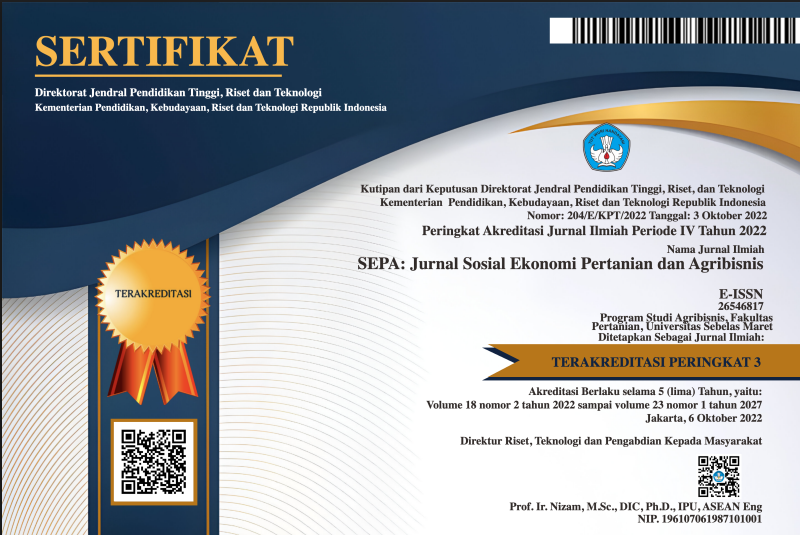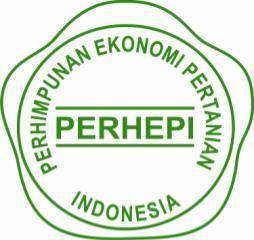KEBERLANJUTAN USAHA TANI MINA PADI DI KALURAHAN SUMBERAGUNG KAPANEWON MOYUDAN DAERAH ISTIMEWA YOGYAKARTA
Abstract
Mina padi is a rice-fish integrated farming system that could increase agricultural field productivity. By implementing this innovation, agricultural land production could increase, and farmers will benefit from two different commodities, namely rice and fish. The involvement of mina padi farmer groups and support from the agricultural extension officer is needed to achieve maximum results in implementing of Mina padi cultivation. One of many areas that have already been implementing a mina padi farming system in the Special Region of Yogyakarta is Sumberagung Village, Moyudan District. In Sumberagung Village, there are 5 mina padi groups with a total of around 64 members that are still actively running mina padi business. The main aim of this study is to determine the sustainability of mina padi farming in Sumberagung Village, Moyudan District, Sleman Regency. The analytical framework used in this study is the Threats, Weakness, Opportunity, and Strength framework by analyzing the threats, weaknesses, opportunities, and strengths of the Mina padi group business activities. This analysis will provide a sustainable development strategy for the mina padi farming system in Sumberagung Village, Moyudan District. The strategies that would sustain mina padi farming business sustainability are intensifying the mina padi farming field, using the tanam jajar legowo (tajarwo) farming system, and reducing pesticide usage, developing mina padi agritourism, and organizing training for mina padi to the younger generation.
Keywords
Full Text:
PDFReferences
Ahmed, N., & Garnett, S. T. (2011). Integratedrice-fish farming in Bangladesh: meeting the challenges of food security. Journal of Food Security, 3(1), 81–92. https://doi.org/10.1007/ s12571-011-0113-8.
Aslan, I., Cinar, O., & Kumpikaite, V. (2012). Creating strategies from TOWS matrix for strategic sustainable development of Kipas Group. Journal of Business Economics and Management, 13, 96–110.
Bai, N., Chen, Y., Zhang, H., Tao, X., & Zhang, H. (2019). Ecological intensification of rice production through rice-fish co-culture. Journal of Cleaner Production, 234, 1002–1012. https://doi. org/10.1016/j.jclepro.2019.06.238.
Baudino, C., Giuggioli, N. R., Briano, R., Massaglia, S., & Peano, C. (2017). Integrated methodologies (SWOT, TOWS, LCA ) for improving production chains and environmental sustainability of kiwi fruit and baby kiwi in Italy. Sustainability, 9 (1621), 1–18. https://doi.org/10.3390/su9091621.
Bungin, B. (2008). Analisis Data Penelitian Kualitatif. Jakarta: Raja Grafindo Persada.
Dey, A., Sarma, K., & Kumar, U. (2018). Prospects of rice-fish farming system for low lying areas in Bihar, India. Organic Agriculture, 9(1), 1–18. https://doi.org/ 10.1007/s13165-017-0204-8.
Hazra, K.K., Swain, D.K., Bohra, A. (2016). Organic rice: Potential production strategies, challenges and prospects. Organic Agriculture, 8, 39–56. https:// doi.org/10.1007/s13165-016-0172-4.
Helms, M. M. & Nixon, J. (2010). Exploring SWOT analysis-where are we now? A review of academic research from the last decade. Journal of Strategy and Management, 3, 215–251.
Hidayati, F., Yonariza, Y., Nofialdi, N., & Yuzaria, D. (2019). Intensifikasi lahan sistem pertanian terpadu: Sebuah tinjauan. Unri Conference Series: Agriculture and Food Security, 1, 113–119. https://doi.org/10.31258/unricsagr. 1a15.
Kuncoro, M. (2006). Strategi Bagaimana Meraih Keunggulan Kompetitif. Semarang: PT Erlangga.
Muhammad, M. (2018). Analisis SWOT sebagai strategi pengembangan usahatani buah naga merah (Hylocereus costaricensis) Kecamatan Wasile Timur Kabupaten Halmahera Timur. Jurnal Agribisnis Perikanan, 11(1), 28–37. https://doi.org/10.29239/j.agrikan.11.1.28-37.
Patnaik, R. & Poyyamoli, G. (2015). Developingan eco-industrial park in Puducherry Region, India-A SWOT analysis. Journal of Environmental Planning and Management, 58, 976–996.
Purbata, A. G., Hadi, S., & Tarumun, S. (2020). Analisis perbandingan efisiensi produksi padi sawah : antara sistem tanam jajar legowo dan sistem tanam konvensional. Jurnal Ilmiah Pertanian, 16(2), 75–87.
Sularno, S., & Jauhari, S. (2017). Peluang usaha melalui agribisnis mina padi untuk meningkatkan pendapatan petani. SEPA: Jurnal Sosial Ekonomi Pertanian Dan Agribisnis, 10(2), 268. https://doi.org/ 10.20961/sepa.v10i2.14136.
DOI: https://doi.org/10.20961/sepa.v18i2.51481
Refbacks
- There are currently no refbacks.



.png)







.png)
3.png)





